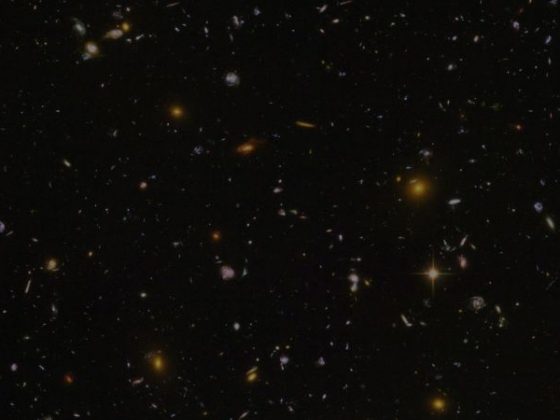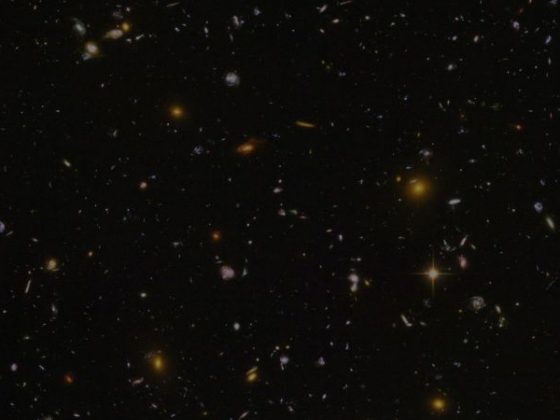February’s full moon, known as the snow moon, is set to peak on Saturday, shining bright around the world in the night sky.
The moon will be at its most full at 7:30 a.m. ET Saturday, according to EarthSky, but to the human eye, the moon will appear full for a couple of days, so the best time to view it will be the nights before and after its peak.
While called the snow moon — a nickname inspired by the heavy snowfall typically seen in February in parts of the United States, according to the Farmers’ Almanac — the golden orb will look almost like any ordinary full moon. But this moon will be a micromoon, meaning it might look slightly smaller than usual.
“It’s just a little bit farther away from Earth than (the moon) typically is,” said Rachel Klima, a planetary geologist and lunar expert with Johns Hopkins University Applied Physics Laboratory in Laurel, Maryland.
“It’s about 10% smaller. So it may look a little bit smaller. But a lot of the time, when people see a really huge moon, it’s usually because it’s low on the horizon, rather than because of the actual distance of it,” Klima said. “(The micromoon) won’t be super, super tiny. It’ll just be a little bit smaller than your average full moon that you look up at.”
The full moon phase occurs when the moon, Earth and the sun are in alignment, in that order. February’s full moon will occur when the moon is at its farthest point from Earth in its elliptical orbit, known as the apogee, Klima said. The micromoon will also be dimmer than the moon typically looks by about 30%, according to EarthSky, allowing for slightly better visibility of nearby celestial objects, without the average luminous interference.
This year, the snow moon will be seen shining next to constellation Leo’s brightest star, Regulus. Near the moon’s peak, on the night of February 23, the star will be seen just below the orb, according to EarthSky.
You obviously don’t need any special equipment to enjoy moon-gazing, but binoculars can be a good tool for those looking to see its features and craters clearly, Klima said. While full moons are best observed in clear skies, even in slightly cloudy weather the moon will occasionally peek through the clouds, she added.
Lunar exploration
On Thursday, the Odysseus lunar lander successfully soft-landed near the moon’s south pole, accomplishing a feat that had not been attempted by any vehicle launched from the United States since the Apollo program ended more than five decades ago. Intuitive Machines’ IM-1 mission also marked the first commercial spacecraft to soft-land on the moon amid a renewed international dash for the lunar surface.
“The nice thing to kind of dream about when you look up at the moon right now is how much renewed activity there is internationally,” Klima said. “We’re basically opening up a new era of lunar exploration. … As these different companies start to land on the moon, we’re going to be able to learn much, much more and really have this whole new world — economic world and scientific world — opened up to us.”
More full moons this year
Of the 12 full moons in 2024, February’s full moon is the only micromoon of the year, while the September and October lunar events will be considered supermoons, according to EarthSky.
Definitions of a supermoon can vary, but the term generally denotes a full moon that is closer to Earth than normal and thus appears larger and brighter in the night sky. Some astronomers say the phenomenon occurs when the moon is within 90% of perigee — its closest approach to Earth in orbit.
Here are the remaining full moons of 2024:
Solar and lunar eclipses
Multiple eclipses will occur in 2024, including two types of lunar eclipses and two types of solar eclipses, according to the Old Farmer’s Almanac.
The most highly anticipated of these events is the total solar eclipse on April 8, which will be visible in parts of Mexico, the United States and Canada. A total solar eclipse occurs when the moon passes between Earth and the sun, completely blocking the sun’s face.
Those within the path of totality, or locations where the moon’s shadow will completely cover the sun, will see a total solar eclipse. People outside the path of totality will still be able to see a partial solar eclipse in which the moon only obscures part of the sun’s face.
A total solar eclipse won’t be visible across the contiguous United States again until August 2044.
An annular solar eclipse will occur on October 2 over parts of South America. This type of eclipse is similar to a total solar eclipse, except the moon is at the farthest point in its orbit from Earth, so it can’t completely block the sun. Instead, annular solar eclipses create a “ring of fire” in the sky as the sun’s fiery light surrounds the moon’s shadow.
Meanwhile, a penumbral lunar eclipse will be visible to many across Europe, North and East Asia, Australia, Africa, North America and South America between March 24 and 25.
A lunar eclipse, which causes the moon to look dark or dimmed, occurs when the sun, Earth and moon align so that the moon passes into Earth’s shadow. A penumbral lunar eclipse is more subtle and happens when the moon moves through the outer shadow, or penumbra, of Earth.
A partial lunar eclipse, in which Earth moves between the sun and the full moon without being perfectly aligned, will appear over Europe and much of Asia, Africa, North America and South America between September 17 and 18.
Check Time and Date’s website to see when each of these eclipses will appear.
Meteor showers of 2024
Sky-gazers can look forward to a multitude of meteor showers this year, according to the American Meteor Society. Here are the dates when meteor events are expected to peak this year.


